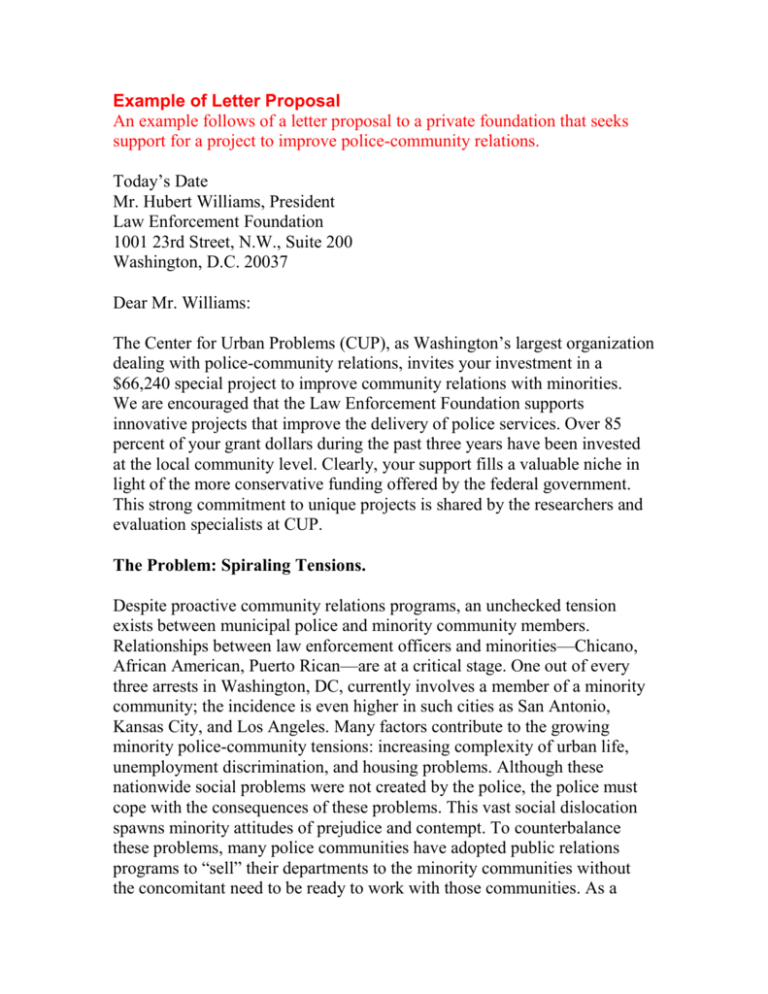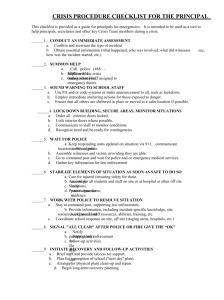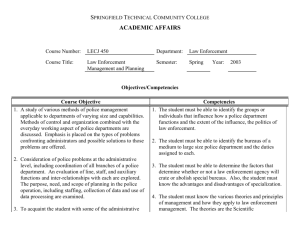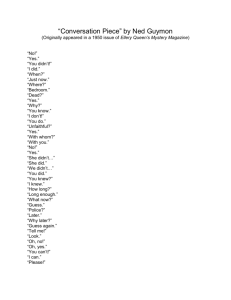LOI Example 1 - Corporate and Foundation Relations
advertisement

Example of Letter Proposal An example follows of a letter proposal to a private foundation that seeks support for a project to improve police-community relations. Today’s Date Mr. Hubert Williams, President Law Enforcement Foundation 1001 23rd Street, N.W., Suite 200 Washington, D.C. 20037 Dear Mr. Williams: The Center for Urban Problems (CUP), as Washington’s largest organization dealing with police-community relations, invites your investment in a $66,240 special project to improve community relations with minorities. We are encouraged that the Law Enforcement Foundation supports innovative projects that improve the delivery of police services. Over 85 percent of your grant dollars during the past three years have been invested at the local community level. Clearly, your support fills a valuable niche in light of the more conservative funding offered by the federal government. This strong commitment to unique projects is shared by the researchers and evaluation specialists at CUP. The Problem: Spiraling Tensions. Despite proactive community relations programs, an unchecked tension exists between municipal police and minority community members. Relationships between law enforcement officers and minorities—Chicano, African American, Puerto Rican—are at a critical stage. One out of every three arrests in Washington, DC, currently involves a member of a minority community; the incidence is even higher in such cities as San Antonio, Kansas City, and Los Angeles. Many factors contribute to the growing minority police-community tensions: increasing complexity of urban life, unemployment discrimination, and housing problems. Although these nationwide social problems were not created by the police, the police must cope with the consequences of these problems. This vast social dislocation spawns minority attitudes of prejudice and contempt. To counterbalance these problems, many police communities have adopted public relations programs to “sell” their departments to the minority communities without the concomitant need to be ready to work with those communities. As a result, there is an ever-widening gap between present and potential minority community acceptance of police behavior. The Solution: Evaluating Police-Community Relations Bureaus. Successful claims regarding the effectiveness of police–community relations bureaus remain undocumented. Police departments are latching on to a new fad without understanding the key components of a police–community relations program. Some features of the bureau approach work; others don’t. The goal of this project is to identify the successful features of existing bureaus, so that success can be delivered more quickly to police departments serving substantial numbers of minority citizens. The CUP research staff will follow standard social science research techniques as detailed in our time-and-task chart, Attachment A. CUP Credentials: National Experience and Networks. CUP is uniquely suited to conduct this evaluation project on police– community relations bureaus. As a nonpolice-linked organization, it can objectively and independently assess current practices. This project represents a systematic continuation of prior CUP efforts in this area with state and municipal organizations as well as private police-related associations. Its staff has a cumulative 100 years of experience in evaluating police-related projects. Finally, local and national networking with 28 regional offices makes it well postured to effectively conduct this assessment. Budget Request: $66,240 Payable Over Six Months. With the demonstrated concern that you’ve shown in the delivery of police services to minorities, I am requesting a grant of $66,240. Quite frankly, the project extends beyond the financial boundaries of CUP. Accordingly, we must now reach out to the community for assistance in what surely is a vital service to the police community. The outcome of this project will touch the operations of over 6,000 law enforcement groups nationwide, resulting in a $13 investment in each existing municipal and state police organization, or a cost of seven cents (7¢) per police official. In making this investment, the Law Enforcement Foundation will be supporting a cost-effective approach to the delivery of police services for the minority communities where major problems exist. Mr. Lloyd Solomon, National Program Director for CUP, can be reached at (202) 123-4567 to answer questions or give further information. Sincerely, Organizational Heavyweight President P.S. Please come visit us and see this important project for yourself. Enclosures: Attachment A: Time-and-Task Chart Attachment B: IRS Nonprofit Certification








